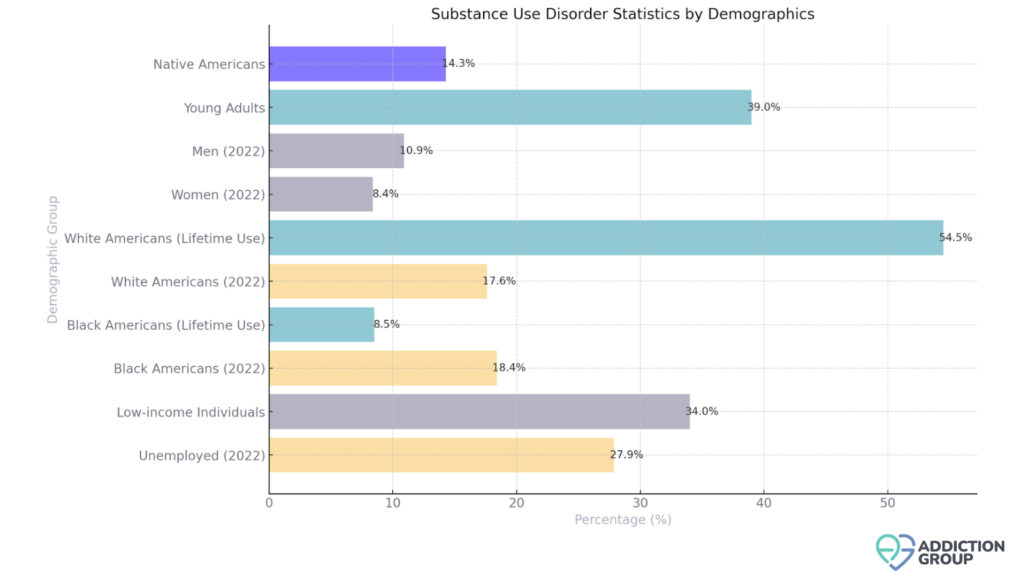Who is Most at Risk for Addiction? Analyze the Demographics


In This Article
Who’s The Most at Risk for Addiction?
Addiction is a chronic disease that affects everyone, regardless of status, race, or age. However, certain demographics are more at risk than others due to various factors.
Understanding these factors and the disparities among demographics can help provide insights for addiction treatment and prevention.

| Demographic | Percentage |
| Native Americans | According to the 2013 NSDUH, Native Americans and Alaskan natives had the highest rate of substance abuse and dependence at 14.3%. |
| Young adults | This age group has the highest rates of substance use disorders. For instance, 39% of individuals aged 18-25 reported using addictive drugs. |
| Men and women | In 2022, about 10.9% of males and 8.4% of females aged 12 and older in the United States had a past-year substance use disorder. |
| White Americans | 54.5% of White Americans reported lifetime illicit drug use. Meanwhile, in 2022, 17.6% of White Americans aged 12 and older had a past-year substance use disorder. |
| Black Americans | Report lower lifetime use of certain drugs like cocaine (8.5%) compared to White Americans (17.6%). In 2022, 18.4% of Black Americans aged 12 and older had a past-year substance use disorder. |
| Low-income individuals | Among those reporting ever using illicit drugs, individuals in the lowest income group were 34% more likely to report having substance abuse-related problems in the past year compared to those in the highest income group. |
| Unemployed | In 2022, 27.9% of unemployed Americans had a substance use disorder in the past year. |
Factors that Contribute to Addiction
There are various socioeconomic factors that influence the development of addiction. These include:
- Peer pressure and experimentation among young adults
- Chronic pain and medication misuse
- Stress, trauma, anxiety, and other co-occurring conditions
- Genetic predisposition to addiction
- Poverty, homelessness, and discrimination
- Low education and unemployment
- Limited access to treatment and healthcare
Some research indicates that adolescents from higher socioeconomic backgrounds may be at risk of binge drinking and drug use. This is sometimes caused by greater financial resources and decreased parental oversight.
Sponsored
Online Therapy Can Help
Over 3 million people use BetterHelp. Their services are:
- Professional and effective
- Affordable and convenient
- Personalized and discreet
- Easy to start
Answer a few questions to get started

Consequences of Addiction Across Demographics
The disparities in addiction across different demographics can have a significant impact on individuals and the community. Substance abuse can interfere with academic progress, careers, and building healthy relationships.
It can be a financial strain and legal troubles. It may even lead to an increased risk of mental health disorders among families.
Furthermore, it can be a massive economic cost. Having a substance abuse problem in the community can lead to healthcare expenses, productivity loss, and increased crime rates.
Sponsored
Get Professional Help
BetterHelp can connect you to an addiction and mental health counselor.
Answer a few questions to get started

Barriers to Addiction Treatment
Although treatment is available for addiction, some may not be able to access proper care. For example, people without housing may lack the documentation and transportation to receive care.
However, there are other systemic inequities that can greatly affect a person’s access to addiction treatment:
Lack of Care for Marginalized Groups
Many treatment facilities and programs aren’t built to address the unique needs of marginalized groups. This includes racial/ethnic minorities, LGBTQ+ individuals, women, and people with specific cultural or religious backgrounds.
Treatment approaches that don’t consider their unique circumstances can be ineffective and backfire. Meanwhile, people who don’t feel understood by their doctor or therapist may be reluctant to engage in treatment.
Social Stigma
The stigma surrounding addiction can be harmful, and people may feel too ashamed to go into treatment. Some are afraid of being judged for having an addiction, and others are worried about being criminalized for it.
People might worry about discrimination in employment, housing, and other social settings. Some may even blame themselves for the addiction and believe they don’t deserve help.
Socioeconomic Disparities
The cost of treatment and medication can make it difficult for some people to seek aid. People without insurance are also less likely to receive addiction treatment.
Meanwhile, people with unstable employment or familial obligations may not be able to find the time to seek treatment. Lastly, limited transportation, especially in rural areas, can prevent people from attending appointments.
How to Address Barriers to Treatment?
You can help reduce barriers to treatment by supporting programs and initiatives that address these barriers. For example, Housing First initiatives provide stable housing for homeless people to help them focus on recovery.
Programs that provide job training and opportunities can help people find employment. They can also improve people’s lives while giving them the means to attend treatment.
Lastly, improving education can help vulnerable youth avoid harmful substance use. This involves providing education on substance abuse and prevention.
Treatment Options for Addiction
Various evidence-based treatment methods are available for overcoming addiction. However, it’s important to understand that there’s no one-size-fits-all solution for addiction.
A doctor or addiction specialist can give you a recommendation based on your specific needs. Available treatment options for addiction include:
| Treatment | Description |
| Inpatient treatment | Involves checking yourself into a rehab facility for 24-hour medical supervision. |
| Outpatient treatment | A treatment program where you are freely allowed to leave the rehab facility. |
| Dual diagnosis treatment | A treatment program that addresses co-occurring mental health conditions alongside addiction |
| Medication-assisted treatment (MAT) | Involves using FDA-approved medication, counseling, and therapy to treat addiction |
| Cognitive-behavioral therapy (CBT) | A short-term therapy technique that explores the link between thought patterns and addiction |
| Support groups and aftercare programs | Provides a much-needed community to help maintain sobriety after treatment |
How to Prevent Addiction
Preventing addiction often involves various multifaceted approaches that address the root causes of addiction. School-based programs educate students about the dangers of substance abuse and help them develop healthy decision-making skills to reduce the likelihood of substance use.
Community initiatives help reduce the risk of addiction by helping those who are struggling with the condition. You may also consider supporting programs and legislation that aid disadvantaged communities.
On a more personal level, you can help prevent addiction by getting involved. If you or someone you know is showing signs of an addiction, don’t hesitate to call for professional help.
What's Next?
Sponsored
Get matched with an affordable mental health counselor
Find a TherapistAnswer a few questions to get started

Related Articles

The Connection Between Addiction and Infidelity

Self-Care for Sobriety: A Complete Approach to Long-Term Recovery

Addiction Apps: Tools for Recovery Support

How Can Families Help? A Guide to Support for Loved Ones

Combating Addiction Stigma: Building Community Support

Is It Dangerous to Use Substances as a Coping Mechanism?
- Wu et al. “Racial/ethnic variations in substance-related disorders among adolescents in the United States.” Arch Gen Psychiatry, 2011.
- NIDA. "Sex and Gender Differences in Substance Use." National Institute on Drug Abuse, 2022.
- Baptiste-Roberts K. & Hossain M. “Socioeconomic Disparities and Self-reported Substance Abuse-related Problems.” Addict Health, 2018.
- “Results from the 2013 National Survey on Drug Use and Health: Summary of National Findings.” SAMHSA, 2014.
- “Drug Abuse Statistics.” National Center for Drug Abuse Statistics, 2023.
- Nolte-Troha et al. “Unemployment and Substance Use: An Updated Review of Studies from North America and Europe.” Healthcare (Basel), 2023.
- Lee et al. “Unemployment and substance use problems among young adults: Does childhood low socioeconomic status exacerbate the effect?” Soc Sci Med, 2015.

